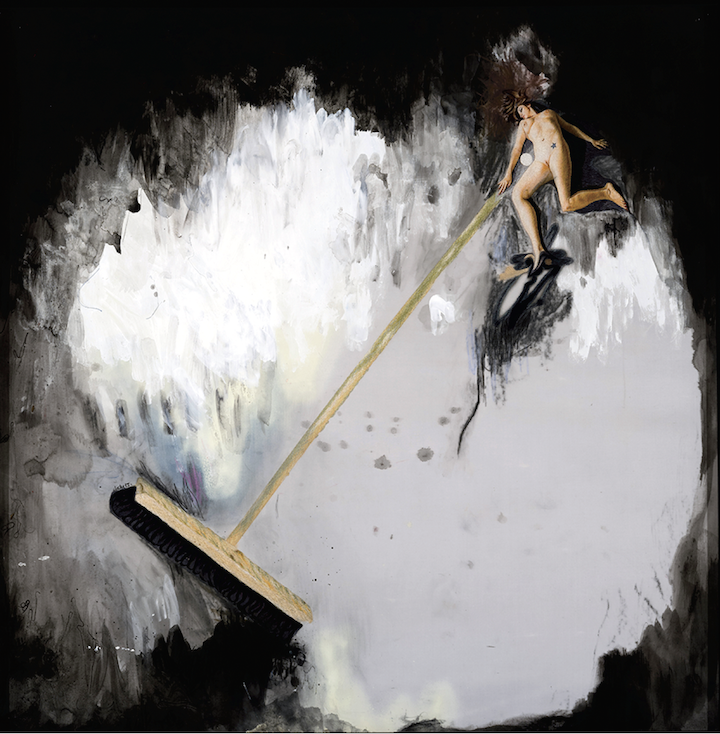Eugénie Cliche

Eugénie Cliche, Noir, 2015, embroidery handmade silk on silk and mixed media, 102 x 102 cm. Photograph: Guy L’Heureux. Courtesy the artist.
Drawing upon her considerable abilities in photography, drawing and embroidery, Eugénie Cliche stitches together seamless portraits of an autobiographical consciousness coming to terms with trauma, loss, sorrow—and profane joy. All of her works are a wily shape-shifter’s various self-portraits and all are marked with Socratic honesty, hubris and brio.
The casual authority of her hand in the fabrication of the works exhibited here is radiant. The integration of the collaged fabric with the drawn/painted element is handled deftly and with real aplomb, however hectic the emotional content.
Her layered truth as a person is both point of fulcrum and palimpsest. She works through grief and anxiety ruefully and with both vigour and rigour. It would be a mistake to underestimate the deeply subversive strain in her work or to confuse it with suburban anger; its chameleon ways, unfettered power of provocation and wilful disruption of prevailing codes and norms speak of deeper consideration and more at stake. Her work disrupts the symbolic order of the patriarchy even as it posits a semiotic itinerary that marks the passage of her own psyche in and through space and time.
The French feminist and psychoanalyst Julia Kristeva is known for her appropriation and development of Plato’s idea of the chora (in the Timaeus) in her La Revolution du Langage Poetique (1974), as a nourishing maternal space that underlies and upends the semiotic fold. Things fructify and multiply with abandon there. Kristeva’s take on the chora has been interpreted in multiple and often overlapping ways: a fluid metaphor for the relationship between the mother and child, a drive-driven, prelingual stage of development, and a non-expressive totality inscribed in a motility of unusual fluency. Kristeva held that it is the mother’s body that mediates between the chora and the symbolic realm.
Cliche’s work is founded upon this same notion of motility, this same chora, and the morphologies of her role as mother and person loom large in the embroidered work. She sees subjectivity as continuously morphing and multifaceted in its mien. The self in process here is simply everything. Indeed, in this work, the semiotic chora is the resonant stuff of the unconscious that dreams are made of and which informs her imagery with thematic integrity.
There is a disruptive surreality and consumptive lushness in this work that is entirely heartfelt and winning. It is quietly and not so quietly explosive. Her embroidery, which betrays a high level of formal invention and sure-handedness in terms of the medium, is at once ornamental, oneiric and oceanic in its mien. Her graphic language, her embroidered language, does not succumb to the symbolic and refuses to be contained or subordinated by it. In any case, that ossified language of the patriarchy and its hegemony is not what interests her. Nor is a ‘pleasing’ or decorative composition, although her work is never fragmented or partial. Hers is a walk on the wild side of the sign.
What she seizes upon and expresses effortlessly is what precedes all symbolic language, at the boundaries of experience. Her rapturous immersion in pre-symbolic modes of communication extends to her performances and indeed, there is a performative dimension to her embroidery, built as it is on excess, decadence and the dance. That is her way out—and, more importantly, her way in: a caesura between the outward symbolic order and the inward semiotic urge. A tidal wave of boundarylessness and luminously chaotic material emerges in hybrid, embroidered spaces that are as captivating and dizzying as they are chromatically rich, sensuous and radically unbound.
Not surprisingly, as noted, her current embroidered work draws on her prior performances over the course of the last many years with Les fermières obsédées, the feminist collective she cofounded with Annie Baillargeon, that practises a rowdy melange of dance, theatre, music and the visual arts. This militant and transgressive embodied ‘burlesque’ is intended to collapse stereotypes and hand-me-down assumptions about the female self in society.
Cliche uses an industrial machine originally designed for hockey and sport logos that she has repurposed to embroider her own personas. She creates her own templates and her source material includes the myriad fabrics she has scavenged over the years at flea markets and goodwill stores—embroideries made, she notes, by anonymous women and preserved now inside her own work.
The body in the works at the Maison de la culture and also in her subsequent (deliciously-titled) show Génie in the box with diamonds at Galerie Lilian Rodriguez is, above all, a dancing body, and its frenetic energy is enlivening and interrogatory. Cliche inserts herself as agent provocateur, assuming different roles at will, often nude, sometimes walking on air or flying far above the fray, as much here in her collages as in her performances. More than anything else, she directs. This allows her to assume or assign different female roles—mother, family matriarch, artist, so forth. Cliche draws on cinematography, collective memory, advertising, cult of celebrity and popular traditions as her evolving understory. Using discarded fragments of embroidery, she embeds her work with a figurative geometry within which she both acts out and works through, finding a place for herself amidst the violence and dynamism of contemporary art and the wider broken world. ❚
“L’ile là où le feu prend” was exhibited at Maison de la culture de Côte-des-Neiges, Montreal, from January 23 to February 28, 2016.
James D Campbell is a writer and curator in Montreal who is a frequent contributor to Border Crossings.

